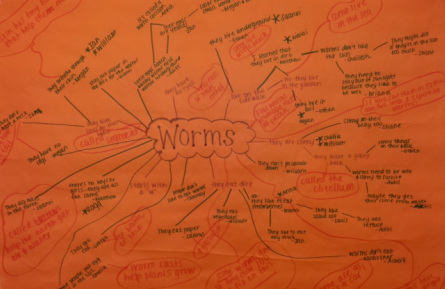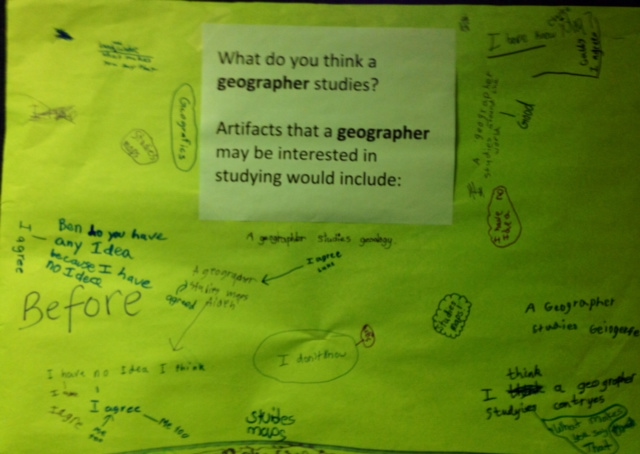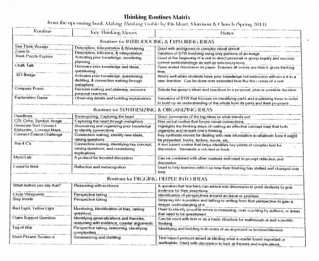What Are Routines? How Are They Used?
What Are Routines?
Ron Ritchhart defines Thinking Routines as Tools, Structures and Patterns :
They are tools that that lead to deeper understanding because they incorporate thinking moves into the learning. Check-out the Thinking section of this blog for more information on Thinking Moves.
They are structures that are:
They are patterns of behavior that:
Teachers have found it useful to focus on one or two routines with their classes so that they truly become part of the routines and structures in the classroom. They will become increasingly easy to remember and implement. As the language and thinking supported by routines become part of the culture of the classroom, the structure of the routine starts to fall away and the cultural forces of the classroom consistently support and encourage thinking.
They are tools that that lead to deeper understanding because they incorporate thinking moves into the learning. Check-out the Thinking section of this blog for more information on Thinking Moves.
They are structures that are:
- Explicit: they have names to identify them
- Goal oriented and purposeful: e.g. Today we will use Chalk Talk to find out what you know about electricity.
- Easy to learn and remember
- Useful across grade levels and subjects
- Helpful to reveal student thinking and make it visible
They are patterns of behavior that:
- Are used over and over
- Become engrained in teachers and students
- Become flexible over time
Teachers have found it useful to focus on one or two routines with their classes so that they truly become part of the routines and structures in the classroom. They will become increasingly easy to remember and implement. As the language and thinking supported by routines become part of the culture of the classroom, the structure of the routine starts to fall away and the cultural forces of the classroom consistently support and encourage thinking.
Revisiting a Routine to Document Changes in Thinking Over Time
|
As routines become ongoing structures and used routinely in a classroom, they are less of a special event and more a means to document changes in thinking and learning over time. Consider revisiting the thinking of a routine and using it as a conversation starter to discover how thinking has shifted and extended. Here are some examples:
Kindergarten students began their science unit study of worms with a teacher led Chalk Talk. After several experiences observing and learning about the worms, the teacher gathered the students two more times around the Chalk Talk and revisited each original comment asking students add to the thinking and express new thoughts. The growing sophistication of knowledge and response is quite striking. On one of the first days of first grade, students responded to the Chalk Talk prompt, What Is Math? After several weeks in school, a return to that prompt revealed a growing sophistication of vocabulary and knowledge of operations.
|
After the first few weeks of school, first graders revisited the worries they listed on an early Compass Points. Clearly, the early worries had either vanished and they were feeling more confident or new concerns popped up. This keeps the teacher up to date on classroom issues.
Third grade students began their first Social Studies unit by responding to prompts about important Social Scientists and the work that they do. The teacher divided the Chalk Talk sheet into two parts: before and after to document the students' growing awareness.
|
Considerations When Revisiting Thinking
When revisiting a routine, it is easy for students to list an additional pile of facts onto the initial thinking. Here are some strategies for encouraging responses that show how thinking has actually changed:
- Look within the routines for prompts such as "How has our learning about Social Scientists changed your thinking?"
- Select actual responses in the first piece and ask "What are you thinking now about where worms live?"
- Select responses from the early work and have students discuss in a pair and share or small group.
- Review original responses and ask "What still puzzles you about this?"
Using Multiple Routines for Deeper Understanding in Response to Literature
In a response to literature, a fourth grade student chose to use four thinking routines to deepen her understanding of the plot and main character along a variety of dimensions. Hatchet by Gary Paulsen was a class read aloud. The student used Zoom-In to analyze the main character, Compass Points to analyze the plot and 3-2-1 Bridge and Headlines to synthesize the author's message. This effort enabled the student to find the story behind the story and to grasp symbolism and subtleties of plot that she had not notice before.
Choosing Routines With Intention
Most of us began using routines in an experimental way to see how they would fit into the already established classroom structure or how they might work with the curriculum. In the beginning, there was little intention with regard to the thinking that students would be doing and how it might deepen learning. Rather, the routine might have sounded easy, or a novel way to move a lesson along. At this point, many puzzled over how we would find the time to include routines with our already overloaded daily schedules. Soon, as we focused on one or two routines and used them routinely, we began to notice that the language and thinking processes associated with them were slipping seamlessly into our curriculum and culture. Asking students, What do you notice? or What makes you say that? was a natural part of our day to day instruction and gave us formative insight into lesson planning. This is a huge step away from the "sage on the stage" classroom, however simply using the language of routines still leaves much thinking untapped. This is why it is important to consider the intention of the learning and using routines in their entirety to tap the type of thinking needed for deep understanding.
As we celebrate the incorporation of the language of thinking into the day to day classroom culture, it is important to remember that routines and structures are also a cultural force and must continue to be a daily part of the classroom. Using routines in their entirety, provides a scaffold for deep thinking and understanding. We are not just seeing and noticing, but we are also thinking and questioning. We are not just making claims and supporting with evidence, we are also contemplating what has been learned and what can still be explored. We are not just telling what makes us say that; but also making connections, extending thinking and understanding learning that still needs to be addressed.
Now that so many are familiar with routines and adept at using them in the classroom, it's time to plan lessons with intention. This means having the Understanding Map in hand and identifying the type of thinking needed for deep understanding. Then use the matrix of routines to choose the sequence of thinking moves that will bring that out in your students and provide you and all members of the class with deep thinking that is visible and a scaffold for all.
As we celebrate the incorporation of the language of thinking into the day to day classroom culture, it is important to remember that routines and structures are also a cultural force and must continue to be a daily part of the classroom. Using routines in their entirety, provides a scaffold for deep thinking and understanding. We are not just seeing and noticing, but we are also thinking and questioning. We are not just making claims and supporting with evidence, we are also contemplating what has been learned and what can still be explored. We are not just telling what makes us say that; but also making connections, extending thinking and understanding learning that still needs to be addressed.
Now that so many are familiar with routines and adept at using them in the classroom, it's time to plan lessons with intention. This means having the Understanding Map in hand and identifying the type of thinking needed for deep understanding. Then use the matrix of routines to choose the sequence of thinking moves that will bring that out in your students and provide you and all members of the class with deep thinking that is visible and a scaffold for all.









